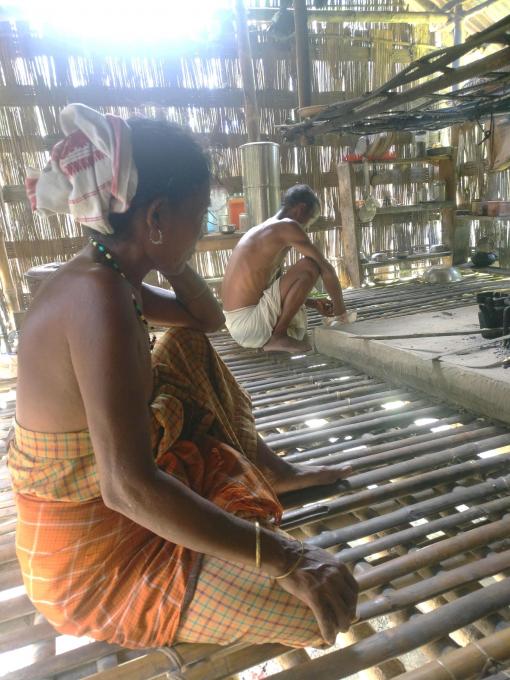When we asked Kangka Pagag what her idea of “adequate” housing would be, she instantly responded that it must accommodate and reflect the aspirations of her three young sons! This earnest response truly set the tone for Gharaunda, a pilot rural housing project by Drishtee Sustainable Communities in the village of Ahumoni in Lakhimpur District, Assam, India.
Housing Challenges
In rural India, the housing shortage is estimated at some 43 million units. As we seek to address this housing crisis, we must consider sustainability as a key part of the solution. As can be seen in the picture above, Ahumoni, like most other villages in Upper Assam, floods during monsoon season—about two to three months each year—and is a victim of the river of fury, the mighty Brahmaputra.
The Mishings, a fishing, farming, and weaver tribal community, find themselves at the mercy of this natural calamity year on year, when their cattle, food grains, and all essentials in the house are at risk of being eaten away by the flood waters. Over the years, you can imagine, they have developed strong coping mechanisms and demonstrated an indomitable human spirit!
All Mishing houses are invariably raised on stilts and are called chang, which literally means ‘elevated.’ Another smart use of space is creating multiple levels within the house by hanging shelves from the roof at varied heights. The choice, too, of construction material—bamboo—is abundantly available, lightweight (and hence not hazardous to life), and inexpensive to keep the maintenance cost low.
Amidst these realities, we circle back to Kangka Pagag’s response and then ask, what are these aspirations? What are their priorities and where does housing feature in those? And then, in this case, how do we strengthen the sustainability mindset of this community?
Key Findings
From our field study in Ahumoni, key findings that emerged were: affordability, durability, and flood resilience—and rightly so! This is a community that builds their houses piece by piece, incrementally, as and when resources become available, speaking to their need for affordability. Their current housing is extremely temporary, requiring frequent fixing, speaking to their aspiration of durability.
It was particularly interesting to learn of the community’s perception that bamboo is a temporary construction material. Kangka Pagag’s three young sons aspire to live in a brick and mortar house because it is considered long-lasting and durable housing. Community members commonly responded that if they had the money, they would build a permanent brick and mortar house, but that, due to economic constraints, they resort to bamboo. Now, this poses a major challenge to Gharaunda, as it needs to demonstrate that, if treated, bamboo can be a permanent housing solution—lasting a long life of 25 to 30 years.
Lastly, we found a need for smarter use of the available space. For example, by elevating food grain storage and cattle space, the community could be greatly shielded from the recurrent floods.

5 Steps to Devise Sustainable Business Models for Rural Housing
1. Participatory Design Process
Gharaunda adopts an inclusive and patient process of diagnosis and co-creation to develop the models that have a high probability of community acceptance. Gharaunda identifies a pilot village and works closely with the community, such that the model reflects the community culture, needs, and aspirations.
2. Community Empowerment
The ownership and accountability must lie with the community. Traditionally, they have been building their own houses, which means that they have sound understanding of local resources, ways to source them, and niche skills of construction. However, what they might need assistance with are slightly more advanced techniques to strengthen the structure and certain best practices that we at Gharaunda can contextualise and bring to them. Here, we put the emphasis on the ‘Do It Yourself’ (DIY) approach by developing manuals and training to equip the community with both the skills and information necessary to materialise their housing vision.
3. Livelihood Generation
Gharaunda aspires to make the community self-reliant by strengthening the value chain that is essential for our prescribed housing to both achieve scale and address the issue of youth unemployment. Certain materials and skills will need to be available locally. Therefore, through capacity-building, Gharaunda will enable the foundation and support systems for new microenterprises to be developed.
4. Environmentally Friendly
The focus here is to map local resources and use them by respecting their physical, biological, and ecological characteristics. Gharaunda works with two materials predominantly—ecological bricks and indigenously grown bamboo—which allow for the building of durable and cost-efficient houses. They are both locally produced, which means adopting them for use eliminates the need for costly transportation and reduces energy consumption. In addition, using locally-sourced materials promotes sustainable construction as a conscious response to rural housing issues.
5. Government Partnerships
It is essential to carve out a role for the government to further strengthen the ecosystem by bringing credibility and legitimacy to the initiative. With the blessing of the government, important resources like information, finance, and human resources can be leveraged from within the existing infrastructure. Gharaunda in Assam has been co-created with the Pradhan Mantri Awas Yojana - Gramin (PMAY-G), the flagship programme of the Prime Minister of India, to achieve “Housing for All by 2022.” On successful adoption of the Gharaunda model by the pilot community, it shall be integrated with PMAY-G, assuring the beneficiaries additional financial and technical support.
In the upcoming months, the programme will demonstrate the entire construction process, from bamboo harvesting and treatment to skilling the local workforce and constructing the prototype. It is a ripe time for us to think—and act—on community-building initiatives that will ensure self-sustenance and well-being!
